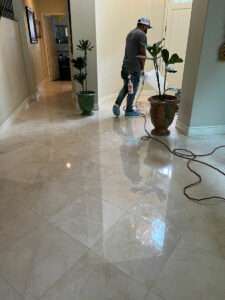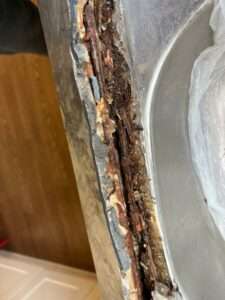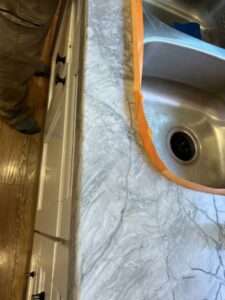Marble Polishing Floors
Marble polishing will make your marble look beautiful and elegant, especially when installed on floors.
Also, it can considerably transform the look of your interior spaces, thus giving your home a luxurious look and feel.
Besides, natural marble has a distinctive veined appearance, meaning that every marble floor is different.

Furthermore, marble is available in various finishes, hardness, and colors, making it one of the most versatile flooring options.
This explains why natural marble is such a popular flooring material globally.
But marble’s natural beauty and luster can fade or disappear with time due to scuffs, stains, scratches, grime, and other elements.
Fortunately, regular marble polishing can help to restore its beauty and elegance.
For Polishing Marble Floors
Marble polishing entails various processes designed to restore marble’s intrinsic beauty.
Also, the polishing process helps make marble look better and more attractive for extended periods.
You don’t have to remove and replace an entire floor, thanks to marble polishing.
You need to hire JK marble maintenance in Los Angeles, and it will undertake the restoration work within the shortest possible time.
Simply put, marble floor polishing will restore your marble’s appeal and elegance, helping it remain attractive for a more extended period.
Also, marble floor polishing will save you thousands of dollars, which you may have spent stripping off the floor and replacing.
So, if your marble floor appears unsightly or unattractive, you simply need to call Los Angeles JK marble polishing experts. And by the time they finish with the marble polishing process, your marble floor will have a glass-like finish.
Reasons to Polish Marble Floors Naturally
When it comes to marble floor polishing, some companies will use wax.
The reasoning behind using wax is that it will not only help polish the marble floor but also help protect it.
But we don’t recommend taking this direction. And, as your local marble restoration expert, we don’t use wax to polish marble.
Wax will make your marble floor lose its luster over time.
The wax will also attract and hold sand, grime, and sand.
And these elements will form a discolored film on the marble’s surface, thus affecting its color.
Furthermore, the wax tends to be yellow over time.
So, with time, your marble floor will start having an unnatural look.
The resin may also cause your marble floor slip, leading to accidents.
Marble Floor Polishing and Restoration Procedures
When done naturally, marble polishing will help to restore your marble floor’s natural luster.
So, if your marble floor has started looking dull, unattractive, or unsightly, we can help restore its natural shine and beauty.
Here are the main procedures we follow during marble polishing and restoration.
Sanding
Marble floor polishing and restoration begins with the sanding process. Also known as grinding, sanding is quite time-consuming. But it’s essential.
If you skip it, the marble may not shine as expected.
Sanding entails the use of diamond and metal-bonded grits to remove lippage and deep scratches that may be present on your marble floor.
We use a heavily weighted floor machine and water for sanding.
Therefore, you won’t have to worry about dust issues.
Once we’ve finished sanding the affected areas, your entire floor will be even.
This makes it much easier to perform the additional steps. Also, the final finish will be uniform. So, if your marble floor has uneven areas or deep scratches, we first need to do the sanding.
Honing
Honing is almost similar to sanding. However, it’s not as aggressive as grinding. The materials and grits we use for sharpening are not as aggressive or rough as the ones we use for sanding. Essentially, honing removes minor to moderate etch marks and scratches.
During the honing process, we rub diamond particles and silicon carbide on the affected surface to remove a small amount of marble. Doing so will flatten any scratches or remove ingrained elements like soil, sand, or stains.
There are three types of honing – hard honing, pad honing as well as powder honing. The method we will apply will depend on the damage to the stone and your preferences.
Polishing
After honing the marble floor, we then proceed to polish it. It’s one of the last steps regarding marble floor polishing and restoration. After sanding and grinding, your marble floor will look somewhat dull. And this is where polishing comes in. Marble floor polishing entails scrubbing the marble surface using resin-bonded diamond grains. The diamonds used for polishing are more minor than those used for honing.
After polishing the floor using resin-bonded diamond grains, we may use powdered abrasives if we haven’t achieved the desired finish. This process entails using polyester fiber pads, a floor machine, and water. The excess powder will be removed, and the floor will be rinsed.
Polishing is about creating tighter scratch patterns designed to reduce the capillaries and pores in the stone. And as a result, your marble floor will have a natural shine. If your marble floor is in decent condition, then polishing alone can be enough to restore its natural glow.
Sealing
Like other types of natural stone, marble tends to be quite porous, making it highly vulnerable to staining.
And this is where sealing comes in. After cleaning, restoring, and polishing your marble floor, we may recommend having the floor sealed.
Sealing will help to prevent various staining elements from penetrating the deeper layers of the stone.
As a result, there will be minimal stains, meaning your floor will retain its beauty, shine, and luster for a more extended period.
But, we should point out that sealing is optional. You can opt to have your marble floor sealed based on your preferences.
Contact Us Today
If you have a home, office, commercial premises, or industrial facility that needs floor polishing, you should contact us today.
We handle all types of marble floor polishing. We also polish marble countertops, vanities, and showers.
Also, we deal with all kinds of stones. Our marble floor polishing services are exceptional but affordable.
Table of Contents
Frequently Asked Questions about Marble Restoration
1. What is marble restoration?
Marble restoration involves repairing and rejuvenating marble surfaces that are damaged, worn out, or dulled over time.
This process can include cleaning, polishing, grinding, honing, and sealing the marble to restore its original shine and beauty.
2. Why is marble restoration necessary?
Marble is a porous stone that can easily absorb liquids and stains. Over time, it can lose its shine and luster due to wear and tear, scratches, etching, or staining.
Marble restoration helps to remove these imperfections and restore the marble to its original state.
3. How often should marble be restored?
The frequency of marble restoration depends on the amount of traffic and use the marble surface receives. High-traffic areas like kitchen countertops or floors in commercial buildings may need restoration every few years.
However, less frequently used marble surfaces may only need restoration every 5-10 years.
4. Can I restore the marble myself?
While DIY marble restoration kits are available, hiring a professional is generally recommended.
Marble restoration requires specialized tools and knowledge to avoid causing further damage to the stone. Professionals also have access to high-quality sealants that can protect your marble for longer.
5. How long does marble restoration take?
The time it takes to restore marble depends on the area’s size and the damage’s extent. A small countertop might only take a few hours, while a large floor could take several days.

Before

After
Pros and Cons of Marble Polishing
Pros
- Enhances the natural beauty of marble surfaces.
- Restores shine and luster to dull marble.
- Helps protect marble from stains and etching.
- Prolongs the lifespan of marble surfaces.
- Can be customized for different finishes (e.g., honed or polished).
Cons
- Requires regular maintenance to maintain the polished look.
- May be costly, especially for large marble areas.
- Can be time-consuming, especially for DIY projects.
- Improper polishing techniques may damage the marble.
- Not suitable for all types of marble; some varieties may not benefit from polishing.
